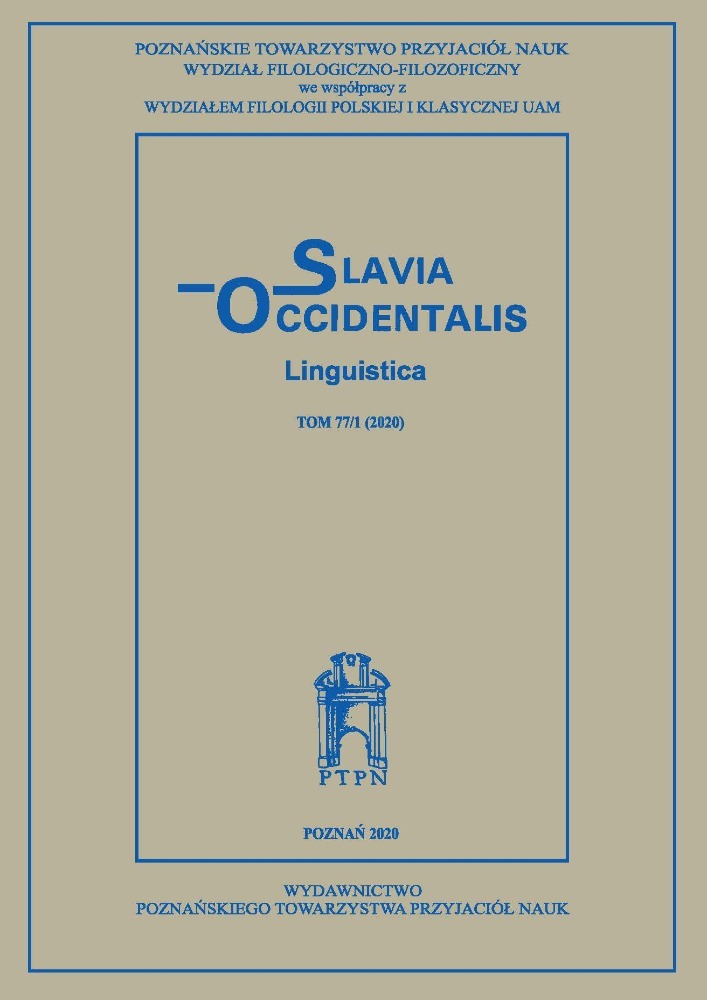Abstrakt
This article examines the increase in frequency of use of the prepositional noun cases in Czech over the last three decades (1990-2019). The author has based his research on the Czech National Corpus where he created five temporally defined subcorpora containing only journalistic texts from the major Czech daily newspapers. Over the period under study, the share of prepositional cases in the total noun tokens has increased from 26.44% to 28.08% (by 1.64%). The share of cases with proper prepositions has
increased the most, while the number of cases with improper prepositions has increased less. The author has identified developmental trends for specific frequented prepositions. According to the author, the increase in the frequency of prepositional cases in Czech is a phenomenon rooted in the “typological dispositions” of the Czech language. However, he considers the stylistic factor (the desire for more explicit, precise expression) to be a factor of more importance, contributing to the increase in the frequency of prepositional cases. On the other hand, some changes in the frequency of use of specific cases, most notably the observed greater frequency of the accusative (+2.21%), is a purely typologically motivated developmental change.
Bibliografia
Anusiewicz J., 1978, Konstrukcje analityczne we współczesnym języku polskim, Wrocław.
Bláha O., 2016, Poznámky k morfologickému vývoji češtiny, Olomouc.
Comrie B., 1989 [1981], Language universals and linguistic typology: syntax and morphology, Chicago.
Cvrček V., Laubeová Z., Lukeš D., Poukarová P., Řehořková A., Zasina A.J., 2020, Registry v češtině, Praha.
Cvrček V., Čech R., Kubát M., 2020, QuitaUp – a tool for quantitative stylometric analysis, Ostrava, https://korpus.cz/quitaup/.
Čechová M., 2016, Slovesné vazby a předložkové konstrukce v pohybu, in: Přednášky z 59. běhu Letní školy slovanských studií, Praha, s. 29-38.
Hausenblas K., 1958, Vývoj předmětového genitivu v češtině, Praha.
Hrdlička M., 2014-2015, O čem vypovídají české předložky?, “Český jazyk a literatura” 65, s. 14-20.
Jelínek M., 2020, Pády prosté ustupují pádům předložkovým, in: Čeština – univerzália a specifika, t. 4, Z. Hladká, P. Karlík (eds), Praha, s. 77-84.
Komárek M., 2012, Dějiny českého jazyka, Brno.
Komárek M., Kořenský J. et al., 1986, Mluvnice češtiny, t. 2, Tvarosloví, Praha.
Kopečný F., 1973, Etymologický slovník slovanských jazyků: slova gramatická a zájmena, t. 1, Předložky, koncové partikule, Praha.
Lotko E., 1997, Synchronní konfrontace češtiny a polštiny, Olomouc.
Osolsobě K., 2017, Deflektivizace, w: Nový encyklopedický slovník češtiny, P. Karlík, M. Nekula, J. Pleskalová (eds), Praha, https://www.czechency.org/slovnik/DEFLEKTIVIZACE.
Popescu I.-I. et al., 2009, Word frequency studies, Berlin. DOI: https://doi.org/10.1515/9783110218534
Sgall P., 1958, Vývoj flexe v indoevropských jazycích, zejména v češtině a v angličtině, Praha.
Skalička V., 2004-2006, Souborné dílo, F. Čermák, J. Čermák, C. Poeta (eds), Praha.
Šonková J., 2008, Morfologie mluvené češtiny: frekvenční analýza, Praha.
Uličný O., 2003, K deflektivizačním tendencím ve slovanských jazycích, in: Česká slavistika 2003: české přednášky pro 13. mezinárodní sjezd slavistů v Lublani, I. Pospíšil, M. Zelenka (eds.), Praha, s. 155-163.
Uličný O., 2021, Lingvobohemistické analýzy, Praha.
Licencja
Prawa autorskie (c) 2022 Ondřej Bláha

Utwór dostępny jest na licencji Creative Commons Uznanie autorstwa – Użycie niekomercyjne – Bez utworów zależnych 4.0 Międzynarodowe.

